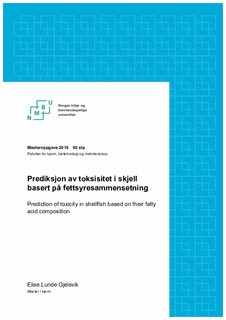| dc.contributor.advisor | Ekeberg, Dag | |
| dc.contributor.author | Gjelsvik, Elise Lunde | |
| dc.date.accessioned | 2018-10-03T11:18:48Z | |
| dc.date.available | 2018-10-03T11:18:48Z | |
| dc.date.issued | 2018 | |
| dc.identifier.uri | http://hdl.handle.net/11250/2566133 | |
| dc.description.abstract | Lipofile marine biotoksiner kan akkumuleres i skjell og være en helserisiko for mennes- ker hvis de konsumeres. Okadasyregruppen er toksingruppen som er den mest vanlige årsaken til diaréfremkallende skjellforgiftning (DSP) i Norge. Toksininnholdet kontrol- leres i kommersielt omsatte skjell. Metoden for måling av toksininnhold har flere ulem- per (Fux et al. 2008, Aanrud 2016). Et alternativ til analysen er å bruke multivariabel statistikk til å finne ut om skjellene er giftige.
Analyse av fettsyreprofiler i en skjellprøve kan være enklere og sikrere enn analyse av toksininnholdet. Statistiske metoder som PCR, PLS, CPLS og variabelseleksjon ble un- dersøkt for å finne en prediksjonsmodell for toksisitet basert på fettsyresammenset- ning. Metodene ble validert ved leave-one-out kryssvalidering og testsettvalidering. PCA ble kjørt for å se på grupperinger eller sammenhenger i variablene. Sammenlig- ning av scoreplot og ladningsplot antydet at Blåskjell inneholder mer trans-fettsyrer og Stillehavsøsters inneholder med mettede fettsyrer.
ANOVA ble gjennomført for å vurdere forklaringsvariablene. Sted kom ut som signifi- kant med Æ = 0.05. Det ble under denne analysen oppdaget en uteligger B-1443 Rund- haugen. Denne prøven representerte en ekstrem algeoppblomstring som kan føre til overestimering dersom den ble inkludert i modellen. Siden sted virket å ha effekt ble residualer hentet ut fra ANOVA og brukt som respons for noen regresjonsmetoder.
De tre beste metodene ble valgt ut til å være PCR med logtransformering, PLS med logtransformering og CPLS med logtransformering. CVANOVA og Tukey post hoc-test viste at CPLS med 5 komponenter var den beste metoden. | nb_NO |
| dc.description.abstract | Lipophilic marine biotoxins can be accumulated in different shellfish and can be a health risk to humans if consumed. Okadaic acid is the toxin group which most com- monly causes Diarrhetic Shellfish Poisoning (DSP) in Norway. Commercially distri- buted shellfish are controlled for toxins. The analysis for detection of toxins have some disadvantages (Fux et al. 2008, Aanrud 2016). One option instead of this analysis is the use of multivariate statistics to discover toxic shellfish.
Analysis of fatty acid profiles in shellfish can be easier and more accurate then measu- ring toxin content. Statistical methods such as PCR, PLS, CPLS and forward selection was explored to obtain a prediction model for the toxicity based on the fatty acid com- position. The methods were validated using leave-one-out crossvalidation and testset validation. PCA was examined to explore groupings or realtions in the data. Compa- risons between scoreplots and loadingplots indicated that Blue mussle contains more trans fatty acids and Pacific oyster contains more saturated fatty acids.
ANOVA was performed to evaluate the explanatory variables. Samplearea was deter- mined to be significant (Æ = 0.05). During this analysis an outlier, B-1443 Rundhau- gen, was detected. This sample represents an extreme algae bloom which could lead to overestimation if included. Samplearea seemed to have an effect on toxicity and resi- duals from the ANOVA were assesed as a respons during the regression methods.
The three best methods were selected as PCR with logtransformation, PLS with log- transformation and CPLS with logtransformation. CVANOVA and Tukey post hoc-test suggested that CPLS containing 5 components was the best method. | nb_NO |
| dc.language.iso | nob | nb_NO |
| dc.publisher | Norwegian University of Life Sciences, Ås | nb_NO |
| dc.rights | Attribution-NonCommercial-NoDerivatives 4.0 Internasjonal | * |
| dc.rights.uri | http://creativecommons.org/licenses/by-nc-nd/4.0/deed.no | * |
| dc.subject | Prediksjon | nb_NO |
| dc.subject | Kjemometri | nb_NO |
| dc.title | Prediksjon av toksisitet i skjell basert på fettsyresammensetning | nb_NO |
| dc.title.alternative | Prediction of toxicity in shellfish based on their fatty acid composition | nb_NO |
| dc.type | Master thesis | nb_NO |
| dc.source.pagenumber | 112 | nb_NO |
| dc.description.localcode | M-KJEMI | nb_NO |

